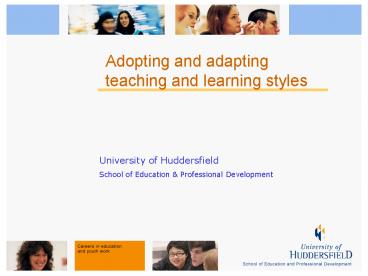Adopting and adapting teaching and learning styles PowerPoint PPT Presentation
1 / 16
Title: Adopting and adapting teaching and learning styles
1
Adopting and adapting teaching and learning styles
2
Learning
- Behavioural (Skinner, Thorndike)
- Learning is a change in observable behaviour
- Change existing classroom behaviours
- Shape observable learning outcomes
- Shape new skills
3
Four approaches
- Contiguity
- Two stimuli become associated when they
repeatedly occur together - Classical conditioning.The pairing of an
automatic response (emotional) (positive or
negative) with a certain stimulus - Operant conditioningThe type and timing of
reinforcement affects learned behaviour. - Social LearningLearning by observing other
behaviours.
4
Contiguity
- Two stimuli become associated when they
repeatedly occur together - Task - give examples from your subject
- Matching games battleships missing words
bingo concentration type games - Discourage incorrect matches. It is imperative
that wrong notions are not initially given!
5
Classical conditioning.
- The pairing of an automatic response (emotional)
(positive or negative) with a certain
stimuluse.g. - fear, anxiety, worry - associated with
difficult concepts, examinations etc - confidence, pride, comfort associated with easy
concepts, fun lessons - Task - give examples from your subject
6
Learning experiences.
- enjoyable, positive so that positive outcomes are
associated with the subject. - learning tasks must be hard enough to challenge
not so hard that failure is inevitable. - use co-operative team structures to establish new
ideas - minimise individual competition (tests are for
progress, not competition) - use familiar and relevant case study material so
that study is associated with everyday life.
7
Operant conditioning.
- The type and timing of reinforcement affects
learned behaviour e.g. - an unpredictable series of reinforcement promotes
persistence at a learning task - reward good learning behaviour
- reinforce new learning - apply previously learned
knowledge to a local issue or make relevant by
collecting current data - use unpredictable reinforcement
- use plenty of praise when learning new concepts
(construction of praise is important - give
reasons) - Surprise tests are better than scheduled ones
8
Social Learning
- Learning by observing other behaviours.(attention
retention reproduction motivation) - Attention is paid to things that are
interesting, exciting, enthusiastic, engaging - Use of props, newspaper clippings, stories
- Reproduction model behaviour to be reproduced
(talking through difficult concepts) - Motivation - positive reinforcement - grades,
marks, praise motivates
9
Cognitive
- (Piaget, Voss, Wittrock)
- Change in observable behaviour is a reflection of
a more important internal change. - Learning is the result of ones attempts to make
sense of the world. - Learner is an active source of plans, goals,
intentions, emotions which are used to sort
incoming stimuli and construct meaning and
knowledge, - Cognitive learning is often experiential.
10
Experiential learning
- On the job experience
- Mini enterprise
- Role play
- Problem solvingUnderstand the problemHave
enough prior knowledge to solve the
problemVisually portray the problem - Encourage role taking and opinion forming
- Encourage different perspectives
- Encourage ownership
11
Perception and Attention
- Which stimuli are attended to which ignored?
Depends on - Rules
- Knowledge
- Patterns
- Beliefs
- Expectations
- Give examples from your own subject
12
Different perceptions
- Different outputs possible from the same input
(different perceptions).Teachers (you) can help
pupils to attend to (focus on) relevance - Provide a context
- Purpose and main ideas of the lesson
- Repeat and review main ideas
- State ideas in students own words
- Identify important central concepts and
supporting examples - Use of headings and sub headings.
13
Arouse curiosity
- For each of the following, give examples from
your own subject - Use surprise
- Use novel ideas or approaches
- Set up a puzzle or open ended issue
- Raise a questions or issue before
knowledge/answer
14
Memory
- Information storage consists of
- words, concepts, skills, strategies (verbalised)
- pictures, imagination (images)
- meanings, perceptions (interpretation)
15
Networks
- Networks of ideas etc. form the basis of memory
reinforced with examples, relationships and sub
concepts - New ideas are integrated into existing network
16
Retrieval
- Help students to retrieve prior knowledge before
proceeding - For each of the following, give examples from
your own subject - Brainstorm existing knowledge
- Hierarchical classification (what I knew, what I
know now, both together) - Pupils make mental images of new ideas
- Rephrase, give examples, develop graphic
representations - Pupils to be active participants

